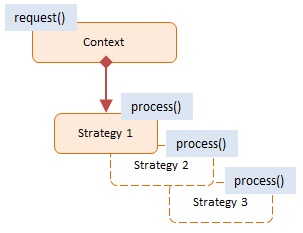Define a family of algorithms, encapsulate each one, and make them interchangeable. Strategy lets the algorithm vary independently from clients that use it.
| Usage in JavaScript: |
|
medium |
The Strategy pattern encapsulates alternative algorithms (or strategies) for a particular task. It allows a method to be swapped out at runtime by any other method (strategy) without the client realizing it. Essentially, Strategy is a group of algorithms that are interchangeable.
Say we like to test the performance of different sorting algorithms to an array of numbers: shell sort, heap sort, bubble sort, quicksort, etc. Applying the Strategy pattern to these algorithms allows the test program to loop through all algorithms, simply by changing them at runtime and test each of these against the array. For Strategy to work all method signatures must be the same so that they can vary without the client program knowing about it.
In JavaScript the Strategy pattern is widely used as a plug-in mechanism when building extensible frameworks. This can be an extremely effective approach.

In this example we have a product order that needs to be shipped from a warehouse to a customer. Different shipping companies are evaluated to determine the best price. This can be useful with shopping carts where customers select their shipping preferences and the selected Strategy returns the estimated cost.
Shipping is the Context and the 3 shipping companies UPS, USPS, and Fedex are the Strategies. The shipping companies (strategies) are changed 3 times and each time we calculate the cost of shipping. In a real-world scenario the calculate methods may call into the shipper's Web service. At the end we display the different costs.
The log function is a helper which collects and displays results.
var Shipping = function() {
this.company = "";
};
Shipping.prototype = {
setStrategy: function(company) {
this.company = company;
},
calculate: function(package) {
return this.company.calculate(package);
}
};
var UPS = function() {
this.calculate = function(package) {
// calculations...
return "$45.95";
}
};
var USPS = function() {
this.calculate = function(package) {
// calculations...
return "$39.40";
}
};
var Fedex = function() {
this.calculate = function(package) {
// calculations...
return "$43.20";
}
};
// log helper
var log = (function() {
var log = "";
return {
add: function(msg) { log += msg + "\n"; },
show: function() { alert(log); log = ""; }
}
})();
function run() {
var package = { from: "76712", to: "10012", weigth: "lkg" };
// the 3 strategies
var ups = new UPS();
var usps = new USPS();
var fedex = new Fedex();
var shipping = new Shipping();
shipping.setStrategy(ups);
log.add("UPS Strategy: " + shipping.calculate(package));
shipping.setStrategy(usps);
log.add("USPS Strategy: " + shipping.calculate(package));
shipping.setStrategy(fedex);
log.add("Fedex Strategy: " + shipping.calculate(package));
log.show();
}
Run
The Namespace pattern is applied to keep the code out of the global namespace. Our namespace is named Patterns.Classic. A Revealing Module named Strategy returns (i.e. reveals) only a single item: the Shipping constructor function, which, in turn, only exposes two methods: setStrategy and calculate.
Here the setStrategy takes in a string and assigns the appropriate strategy within the Strategy module. All three shipping strategies, i.e. UPS, USPS, and Fedex, are kept private inside the module's closure. Again, this is a nice example of OO encapsulation and data hiding using JavaScript patterns.
The Patterns object contains the namespace function which constructs namespaces non-destructively, that is, if a name already exists it won't overwrite it.
The log function is a helper which collects and displays results.
var Patterns = {
namespace: function (name) {
var parts = name.split(".");
var ns = this;
for (var i = 0, len = parts.length; i < len; i++) {
ns[parts[i]] = ns[parts[i]] || {};
ns = ns[parts[i]];
}
return ns;
}
};
Patterns.namespace("Classic").Strategy = (function () {
var Shipping = function () {
var company = "";
this.setStrategy = function (name) {
if (name === "UPS") {
company = new UPS();
} else if (name === "USPS") {
company = new USPS();
} else if (name === "Fedex") {
company = new Fedex();
}
};
this.calculate = function (package) {
return company.calculate(package);
}
};
var UPS = function () {
this.calculate = function (package) {
// calculations...
return "$45.95";
}
};
var USPS = function () {
this.calculate = function (package) {
// calculations...
return "$39.40";
}
};
var Fedex = function () {
this.calculate = function (package) {
// calculations...
return "$43.20";
}
};
return { Shipping: Shipping };
})();
// log helper
var log = (function () {
var log = "";
return {
add: function (msg) { log += msg + "\n"; },
show: function () { alert(log); log = ""; }
}
})();
function run() {
var shipping = new Patterns.Classic.Strategy.Shipping();
var package = { from: "76712", to: "10012", weigth: "lkg" };
// the 3 strategies
shipping.setStrategy("UPS");
log.add("UPS Strategy: " + shipping.calculate(package));
shipping.setStrategy("USPS");
log.add("USPS Strategy: " + shipping.calculate(package));
shipping.setStrategy("Fedex");
log.add("Fedex Strategy: " + shipping.calculate(package));
log.show();
}
Run